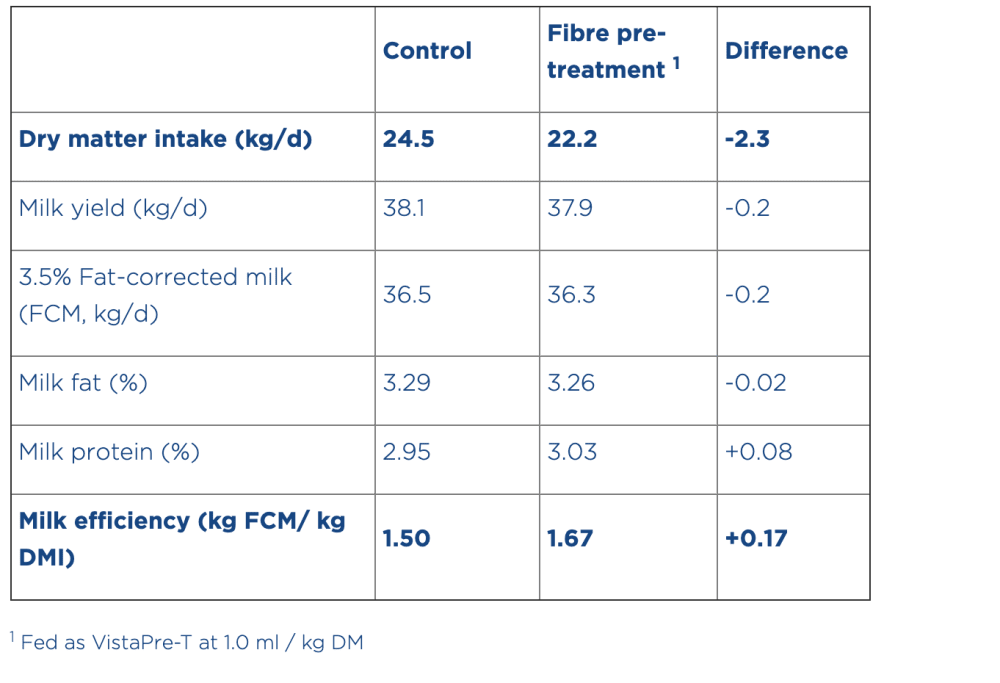More efficient fibre digestion an opportunity to boost margins this winter
Published Thursday, 10th January 2019Extracting more milk from the same feed is always appealing, and by focusing on better fibre digestion it’s possible to do just that, states AB Vista’s Dr Derek McIlmoyle.
Total dietary fibre typically accounts for 45-50% of the dry matter (DM) in most dairy rations, yet the gains possible from improving the digestibility of that fibre are too often overlooked, warns Dr Derek McIlmoyle, AB Vista’s EMEA technical director.
“Dietary fibre is important both as an energy source and for correct rumen function, but it’s one of the slowest digesting fractions within the diet,” he outlines. “Any improvements in fibre digestion can therefore significantly improve overall diet digestibility and the amount of milk produced from all feeds, not just forage.
“And this winter in particular, with forage in limited supply in some regions following the dry summer, extracting every possible bit of value from the ration will be critical to keeping additional feed costs to a minimum.”
Increasing fibre digestibility
According to Dr McIlmoyle, when rumen conditions are optimal, the rumen digestibility of the plant cell walls that make up most of the fibre in the ration is around 65%. However, what’s actually digested is typically much lower, and can be as low as 35% when conditions in the rumen really deteriorate due to the inclusion of high levels of concentrate causing sub-acute ruminal acidosis (SARA).
“Until recently, the only practical way to increase fibre digestibility was to improve rumen function,” he continues. “This usually involved better ration formulation to balance energy supply in the rumen and minimise acidosis, plus the addition of a slow-release rumen conditioner like Acid Buf or Vistacell live yeast to help optimise rumen conditions for fibre-digesting microbes.”
However, research carried out by Agriculture and Agri-Food Canada (AgCanada) has shown that application of a fibre pre-treatment to total mixed rations (TMR) before feeding can further increase fibre digestibility. In fact, the same fat-corrected milk (FCM) yield was achieved with 2 kg/day less dry matter intake (DMI), an improvement in milk production efficiency of 11.3% (1.67 vs. 1.50 kg FCM/kg DMI), with some gain also seen in milk protein content (see Table 1).
Table 1 – Effect of fibre pre-treatment on early lactation milk production efficiency
The trial was carried out at the Lethbridge Research and Development Centre, Alberta, and used 60 early lactation Holsteins fed a silage-based TMR. Cows were either fed the control TMR with no pre-treatment, or the TMR following application of 1.0 ml/kg DM of a Trichoderma reesei-derived fungal extract applied before feeding.
Pre-treatment effects
“The pre-treatment acts to roughen and create pits in the surface of the fibre in the ration, and so increase both the rate and extent of bacterial colonisation of that fibre once in the rumen,” explains Dr McIlmoyle. “This reduces the lag time before fibre digestion in the rumen begins by around one hour, and leads to improved overall digestibility of the ration, and greater energy supply to the cow.
“The result is more production from the same feed, or – as in this case – the same production from less feed. The possible increase in milk protein seen in the trial is also indicative of improved energy supply, and similar results have been achieved in other trials that have taken place in Europe.”
In a UK trial using 50 first lactation heifers, pre-treatment increased TMR D-value (63% to 67%), milk yield (+1.3 litres/cow) and milk protein (3.58% to 3.70%). Improvements in fertility were also observed, with a higher rate of confirmed pregnancies (84% vs 64%). A larger-scale trial in Bulgaria using 310 cows fed a maize silage-based TMR saw feed efficiency improvements lift yields by 1 litre/cow.
“The impact of these improvements can be particularly beneficial during early lactation,” Dr McIlmoyle adds. “With energy requirements exceeding intake for all cows during the first few weeks post-calving, anything which can help reduce this negative energy balance by improving energy supply has potentially far-reaching benefits for the whole lactation.”
On-farm yield increase
On-farm experience backs up the results seen in the research. For Ian Burgoyne, who milks 140 cross-bred* cows near Crocketford, Dumfries, using a pre-treatment increased average daily yield by around 1 litre/cow.
“We were looking at the options to increase milk output, but without buying more feed,” he explains. “We wanted to get more out of the high proportion of grass silage we feed, and improving fibre digestion by pre-treating that silage made a lot of sense.”
Rations are formulated by Carrs-Billington nutritionist Mark Worden using the latest rationing system from Trouw Nutrition, which more effectively models the nutritional value each feed provides. Samples of the silage tested on-farm with a hand-held NIR analyser showed the potential to raise silage energy levels from 11.1 to 11.9 MJ ME/kg DM if a pre-treatment was added.
Cow energy status
“Around three weeks after we started using the pre-treatment – it takes time for the rumen microbes to adapt – we could clearly see that yields had increased by around a litre per cow,” Mr Burgoyne continues. “However, for me the real return came in the overall health of the animals.
“For a start, the cows had shinier coats and looked more content. Then as we continued through the winter we found that fertility was also improving, which we put down to an improvement in the overall energy status of the cows.
“We’re 100% grass-based in terms of forage, so having the cows get more energy out of the grass silage we make – and the ration as a whole – can have a big impact over time.”
Footnote:
Farm facts – Shenrick Farm
140 cows, 3x cross-breeds*
154 ha (380 ac) grassland
3-4 cuts grass silage
Rolling 12-month average:
- 8,800 litre/cow
- 4.18% butterfat
- 3.38% protein
385-day calving interval
Closed herd, surplus heifers sold
Grass silage-based winter TMR:
(formulated using NutriOpt)
- 1st & 2nd cut grass silages
- Wholecrop cereal silage
- Carrs-Billington custom blend
- VistaPre-T pre-treatment
16% CP parlour compound
Beef calves reared on-farm
* Montbelliard or Fleckvieh over Holstein, then crossed to Norwegian or Swedish Red, then back to Holstein with sexed semen.
Latest news
Stay ahead with the latest news, ideas and events.

Online Feed Fibre Calculator
Calculate the percentage of dietary fibre in your feed
Our calculator is designed for nutritionists and uses averages of global raw materials to calculate the dietary fibre content (plus other more in-depth fibre parameters) of finished animal feed. These parameters are available within AB Vista’s Dietary Fibre analysis service (part of our NIR service).
Sign up for AB Vista news
A regular summary of our key stories sent straight to your inbox.
SUBSCRIBE© AB Vista. All rights reserved 2025
Website T&Cs Privacy & Cookie Policy Terms & Conditions of Sale University IDC policy Speak Up Policy


























